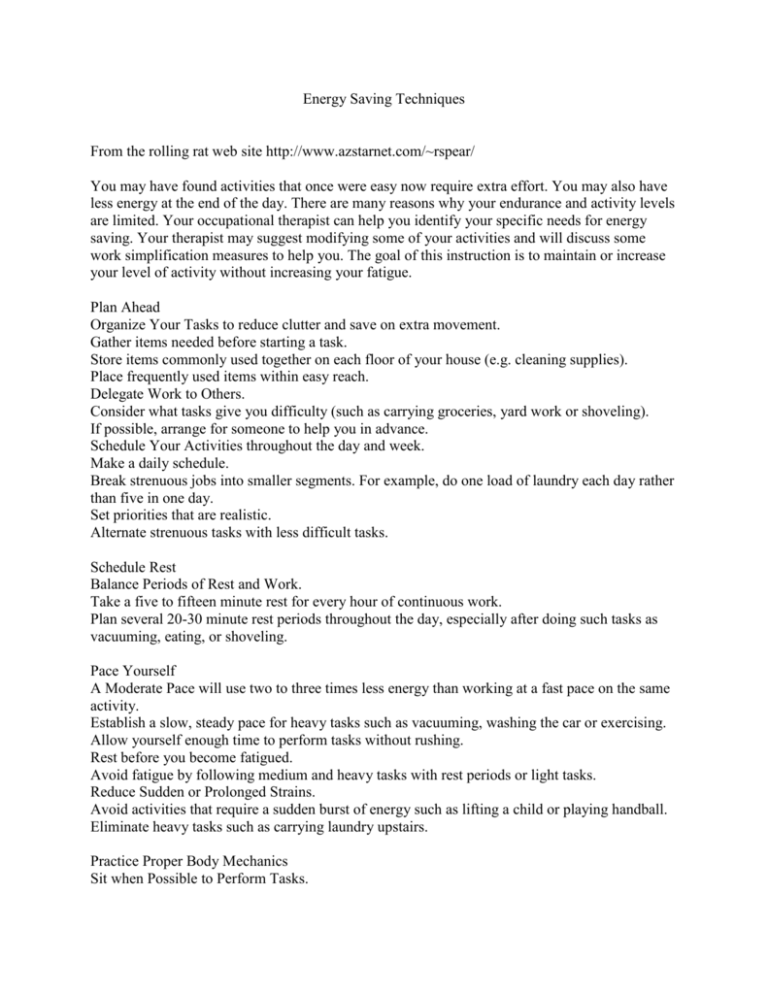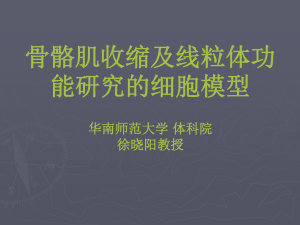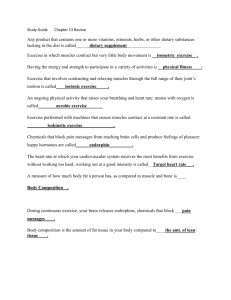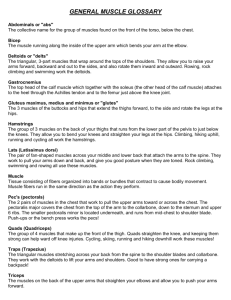Energy Saving Techniques - Polio Outreach of Washington
advertisement

Energy Saving Techniques From the rolling rat web site http://www.azstarnet.com/~rspear/ You may have found activities that once were easy now require extra effort. You may also have less energy at the end of the day. There are many reasons why your endurance and activity levels are limited. Your occupational therapist can help you identify your specific needs for energy saving. Your therapist may suggest modifying some of your activities and will discuss some work simplification measures to help you. The goal of this instruction is to maintain or increase your level of activity without increasing your fatigue. Plan Ahead Organize Your Tasks to reduce clutter and save on extra movement. Gather items needed before starting a task. Store items commonly used together on each floor of your house (e.g. cleaning supplies). Place frequently used items within easy reach. Delegate Work to Others. Consider what tasks give you difficulty (such as carrying groceries, yard work or shoveling). If possible, arrange for someone to help you in advance. Schedule Your Activities throughout the day and week. Make a daily schedule. Break strenuous jobs into smaller segments. For example, do one load of laundry each day rather than five in one day. Set priorities that are realistic. Alternate strenuous tasks with less difficult tasks. Schedule Rest Balance Periods of Rest and Work. Take a five to fifteen minute rest for every hour of continuous work. Plan several 20-30 minute rest periods throughout the day, especially after doing such tasks as vacuuming, eating, or shoveling. Pace Yourself A Moderate Pace will use two to three times less energy than working at a fast pace on the same activity. Establish a slow, steady pace for heavy tasks such as vacuuming, washing the car or exercising. Allow yourself enough time to perform tasks without rushing. Rest before you become fatigued. Avoid fatigue by following medium and heavy tasks with rest periods or light tasks. Reduce Sudden or Prolonged Strains. Avoid activities that require a sudden burst of energy such as lifting a child or playing handball. Eliminate heavy tasks such as carrying laundry upstairs. Practice Proper Body Mechanics Sit when Possible to Perform Tasks. Sit on a low stool when working at low levels such as gardening or on a high stool for high level work such as woodworking. Sit at a table for such tasks as folding laundry. When Sitting To Work, Use balanced posture Elevate your legs if sitting for long periods. Avoid crossing your legs or ankles. Shift your weight to change position in order to distribute the work over different muscles. Avoid a bent, stooped, or cramped position. Take a brief standing or walking break after every 30-60 minutes of sitting. Avoid sitting in chairs with your legs unsupported. When Standing To Work, Use balanced posture Shift your weight to change position to distribute the work over different muscles. Rest one foot on a low stool, drawer or ledge and alternate feet frequently. Take a brief sitting break after every 30-60 minutes of standing. Adjust Work Heights to reduce unnecessary straining of your neck, back or arms. When sitting or standing, adjust your table or chair height in order to work without bending. Keep your shoulders relaxed while working. Use an adjustable drafting table or other writing surface. When working with a Video Display Terminal (VDT), position the screen at eye level. Use a book or document holder or raise the material to eye level in order to read without bending over the surface When doing tasks such as gardening or shoveling, use long handled tools to prevent working in a stooped or bent position. When Handling Objects, Bend at your hips and knees when lifting objects. Lift using your legs, and maintain your natural back curves Carry items close to your body using both hands. Use a backpack or shoulder bag for carrying. Place the shoulder bag strap around your neck and across your chest. Keep the bag to the front side of your body. The shoulder strap should be wide and padded to distribute pressure. Slide or roll objects along a counter top, bench or floor. Use wheeled carts, dollies, or wheelbarrows when moving heavy or bulky objects such as luggage, groceries, laundry or farm and garden tools. Alternate hands when performing repetitive or prolonged activities such as painting. Limit Overhead Work Avoid Working With Your Hands Overhead for prolonged periods of time. When doing such tasks as dusting or painting, alternate hands frequently. Use long-handled tools such as a reacher or extended paint roller. Use a sturdy stool or step ladder when needed. Adjust work heights such as clotheslines, shelves, or tables to avoid over-reaching. Place frequently used items at chest level or below for easy reach. Store heavy items between hip and chest level. Limit Isometric Work Isometric Work occurs when muscles are continually tensed and not moving Examples of isometric work include your hand and arm muscles when gripping a hammer or your shoulder muscles when pushing a cart. Release Your Grip to relax and rest your muscles. Change hands when carrying items such as a suitcase or purse. When driving, keep shoulders relaxed and avoid tensing your muscles. Take frequent breaks when using hand tools. Rest your forearms on the work surface. Use A Tool or Adapted Equipment to make your job easier. Use a built-up handle on utensils. Use a wet washcloth or rubber gripper to open a jar. Use a lever door-handle. Breathe Evenly to maintain a steady supply of oxygen to your body. Avoid holding your breath during straining tasks such as opening a jar or having a bowel movement. Blow air out while straining. Breathe in through your mouth and out through puckered lips during times of exertion such as rising from a chair or lifting objects overhead. Do not hold your breath. Breathe from your diaphragm to save energy. The small muscles of the chest tire more quickly. Identify Effects of Your Environment Avoid Temperature Extremes and Humidity that may easily increase your fatigue. In hot or humid weather, you have the additional strain of cooling your body. Light-headedness, dizziness, or fainting spells can result from overexertion in warm temperatures. Take moderately warm showers. Avoid saunas and hot tubs. Use a bathroom exhaust fan or leave the door or window open slightly to help with air circulation when bathing or showering. Schedule outdoor activities to take advantage of comfortable times of the day. During the Cold Season: Wear layers of warm, light-weight clothing. Wear warm, waterproof shoes or boots. Cover your hands and head to prevent heat loss. Turn away from the wind and breathe through your nose or use a mask or scarf. During the Warm Season: Wear a brimmed hat. Work or rest in the shade. Wear light colored clothing to reflect the sun's heat. Avoid overexposure to direct sunlight. Eliminate Smoke and Noxious Fumes from the air you breathe. Smoke will lower your blood oxygen level and make activities more fatiguing. Ask family or friends to smoke outside. Keep the chimney in your home clean to prevent smoke from entering your house. Ventilate the area when working around noxious fumes from things such as paint, gasoline, cleaning products or car exhaust. Reduce Stress Monitor tension that builds throughout the day. Be aware of physical reactions to stress: upset stomach, tension headache, a stiff neck or back. Emotional response to stress can include irritability, depression and fatigue. Anticipate fatigue and stress responses to activities you encounter. Plan ways to deal with stressful situations such as taking a short nap during long family gatherings. Spend time relaxing before and after any potentially stressful encounters. Defuse stress before it becomes a problem. For example, if the noise and movement of young children is stressful to you, limit your exposure when possible. Find a healthy way to express your fears or concerns. You may want to talk to your physician or clergy, join a support group, etc. Learn relaxation techniques. Breathing exercises Progressive muscle relaxation Audio tapes and books Social/leisure activities Guided imagery Exercise Physical Exercise can help you sleep better and recover from stress more quickly. Make scheduled physical activity part of your daily routine. If you have previously led a sedentary lifestyle, check with your physician before starting any new physical activity. Expand Leisure Activities Develop Leisure Interests Explore new hobbies that are interesting to you and within your activity tolerance. Continue your interest in productive leisure activities such as woodworking, needle work, gardening, card clubs or golf. Modify How You Perform an activity to reduce stress and fatigue. Use a low stool or chair and a long-handled tool in the garden and yard. Reduce the amount of time and the intensity involved in a game such as tennis. Recognize the stress associated with competitive sports and games whether you are participating or watching. Conclusion Remember, your body requires a balanced amount of work and rest. Stop the activity and rest if your activity causes: shortness of breath excessive fatigue chest pain other symptoms of over exertion light-headedness These symptoms indicate you are either working too fast or the work is too demanding. Review activities that seem to give you the most trouble and apply these energy-saving principles. By using your energy wisely, you can begin to Work toward maintaining your independence as well as making your life more productive and fulfilling. Mayo Foundation for Medical Education and Research








